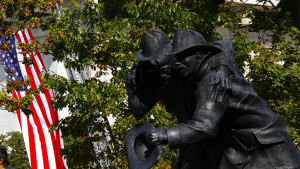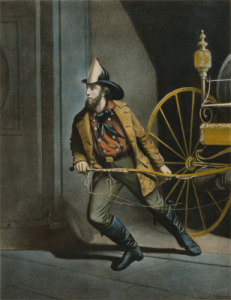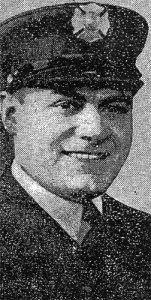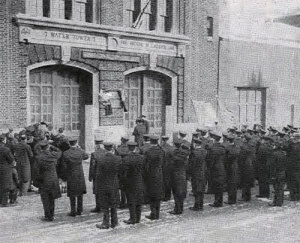Firemen and flags unite in sorrow and joy

Picture a fireman. You see a helmet and hose, right? But do you also see an American flag? Based on these stories from the past, you should. The examples come from 150, 100 and 70 years ago.
1865
William Hoover, a Philadelphia fireman, left his job in 1862 to sign up with the 99th Pennsylvania Volunteers. Two years later, he was captured during the siege of Petersburg, Virginia. In 1865, due to exposure and “brutal treatment” by his captors, Hoover died.

A Philly newspaper recorded that his wake was attended by relatives, friends, and fellow members of the Independence Hose and Steam Company. The newspaper added that “the old bell on the engine house tolled the sad news of his death.”
As a sign of his military service, Hoover’s coffin was covered with an American flag.
1915
In Springfield, Missouri, children at a grammar school took part in a surprise fire drill, overseen by fireman from a nearby station. It wasn’t the usual drill, however, because it included a flagpole.
The students had been crestfallen when they learned that vandals had made off with the school’s flagpole in the middle of the night, so the principal turned to the fire chief for assistance.

A truck with an extension ladder arrived at the school, and the chief made sure the drill was held so that the kids were outside to see the replacement of the flagstaff. A ladder lifted a firemen to the top of the building to replace the pole and attach the roping so a banner could fly.
1945
Eighty years after William Hoover died in the Civil War, another firefighter – George Nigro – succumbed in the line of duty while fighting during World War II. He was “killed in action…in Germany,” The New York Times reported, “where he was a staff sergeant with the Eleventh Infantry.”

He had belonged to Engine Company 229 in Brooklyn, New York, where he served as a fireman for six years before enlisting in February 1944. Fewer than 13 months later, he died at 29.
The newspaper reported that the fire commissioner “ordered the American flag displayed at half-staff for five days on firehouses.”
Two years later, Nigro’s mother attended a ceremony unveiling a plaque commemorating her son’s sacrifice for his country. Recently, his name was also added to the Fallen Firefighters Memorial Wall in Albany, New York.
